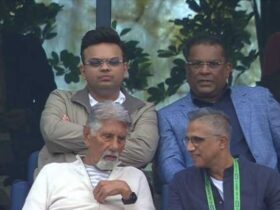Have we ever considered the possibility that Jasprit Bumrah was put on this planet to make Pat Cummins look human? No? Because I think we should.
I mean, Cummins has just become the first Australian captain in a decade to win the Border-Gavaskar Trophy. He took 25 wickets in a sweaty, combative brawl, the highest for his side. He averaged over three times as much as a batter as Rohit Sharma, more than Shubman Gill, and nearly as much as Virat Kohli. He bowled two contenders for ball of the series, one to dismiss Rohit, one to KL Rahul. At every moment he looked like Jon Hamm should have been his understudy as Don Draper, and still Bumrah won the Player of the Series award and nobody’s quibbling, and this sounds like I’m telling you how good Bumrah was without telling you how good Bumrah was. But if anyone could quibble, without being laughed off stage, it would be Cummins. And if there’s one person who definitely, 100%, is too polite to actually quibble, that too is Cummins.
Because other than in the opening Test, in Perth, Cummins was pretty much all over this triumph, in that endearingly low-key and gentlemanly way that in no way should be mistaken for an absence of main-character energy. It was his short-ball barrage that poleaxed India in the second innings in Adelaide. It was his pair of 40s at the MCG that pulled the game away from India. It was his double-wicket over on the final morning there, after an hour of solid India resistance, that gave Australia the opening, and his wicket of Yashasvi Jaiswal later that all but sealed it. It was his wicket of Rishabh Pant at the SCG, and then two more from the lower order the next morning that ensured Australia wouldn’t have a big chase.
He bossed the big duels, dismissing Rohit and Pant four times, and Rahul thrice. Not dismissing Virat Kohli even once seemed either like a rare oversight or an act of munificence so that the rest of his attack had some big moments. Cummins was impactful, 14 of his 25 wickets coming in the first or second over of a spell, which was validation twice over – of his status as a bowler and also as a captain who knew exactly when to bring on his best bowler.
As much as he bowled beautiful, catching those edges, hitting the top of off, he bowled ugly well too, the mid-innings grunt work (it’s difficult to reconcile that he’s not always opening the bowling), drying up those runs, cranking up that pressure. As the ball got older, he went to his bouncers, taking nine wickets with them (more than anyone else) and ensuring that Australia’s threat rarely waned as the innings progressed. Bouncers aren’t often remembered as a ball of a match or series, but the one to Pant in Adelaide was beautiful in its execution and suddenness. And he was durable, bowling six-over second spells in the third or fourth innings of a Test at the end of a series, with the same intensity as he did the first spell of a series.
There’s a side point to be made about aesthetics, which is necessarily subjective and needs to be prefaced with: Cummins is not boring to watch. But. He’s not as fun or thrilling to watch as Bumrah, or not fun and thrilling in the same way. It’s not perfectly analogous but it doesn’t feel entirely wrong to say that if Bumrah is the Wasim of this age, Cummins is its McGrath.
Anyway, this much we’re familiar with. What’s more interesting at the moment is where we are three years into the Cummins Captaincy. At one level, if you placed his captaincy against that of some of his counterparts and contemporaries, it isn’t feted (or fetishised) nearly as much, or in the same ways. Nothing like the halo around Ben Stokes, for example. Or Rohit Sharma, whose defining legacy, until India’s recent red-ball travails, was set to be his cultural transformation of India’s white-ball cricket. And Kohli before him, who set greater store in winning every game India played than perhaps any India captain before him. Cummins’ opponent in the WTC final, meanwhile, will be South Africa’s first full-time black African Test captain. We don’t need reminding of how potentially transformative a tenure that could be.
Amidst these, Cummins’ captaincy comes across a little normcore. No obvious philosophy or schtick. No radical shift in style. No memorable tactical gambits (although his captaincy in the World Cup final was outstanding), other than to bring on his best bowler at the right time. An immeasurable impact of his leadership is how the Australian team has become less boorish. I’m not saying this is a side of cuddly teddy bears sitting on little fluffy clouds, but there’s lesser variance now between how they play on the field and how they appear off it. Somewhat in the image of their leader.
That he is leading an imperfect side, or a vulnerable one – or at least one that doesn’t feel nearly as invincible as the great modern Australian sides – makes it oddly humanising. They’ve lost a Test at home to West Indies. They didn’t win their last series in India (though only one Australia side has in over 50 years). But they didn’t win their last series in Sri Lanka either. And their World Cup campaign began so poorly that had they lost to Afghanistan at the Wankhede, who knows how it might have ended. And, of course, there’s the 2023 Ashes. Had Manchester weather behaved itself, Cummins might be sitting here only the second captain ever to have lost a five-Test series from 2-0 up. Such a result alone would have put a different gloss on his captaincy. As it is, he and Australia both looked a little frazzled by Bazball by series’ end.
But three years in, here’s some bottom-line talk. In terms of win-loss ratio, Cummins is now the most successful Test captain since 2010 (among those with ten or more Tests as captain) and has slipped into the top ten most successful of all time.
Australia are in a second consecutive World Test Championship final, having won the first. They are ODI world champions. They hold the Ashes and now the Border-Gavaskar trophy. They hold every single bilateral series trophy there is, even if that is one of those made-up achievements that cricket has lately grown fond of. In short, under Cummins, they remain very Australia, very winning.
And it’s probably time to consider the possibility that, for once, Bumrah has not succeeded.










Leave a Reply